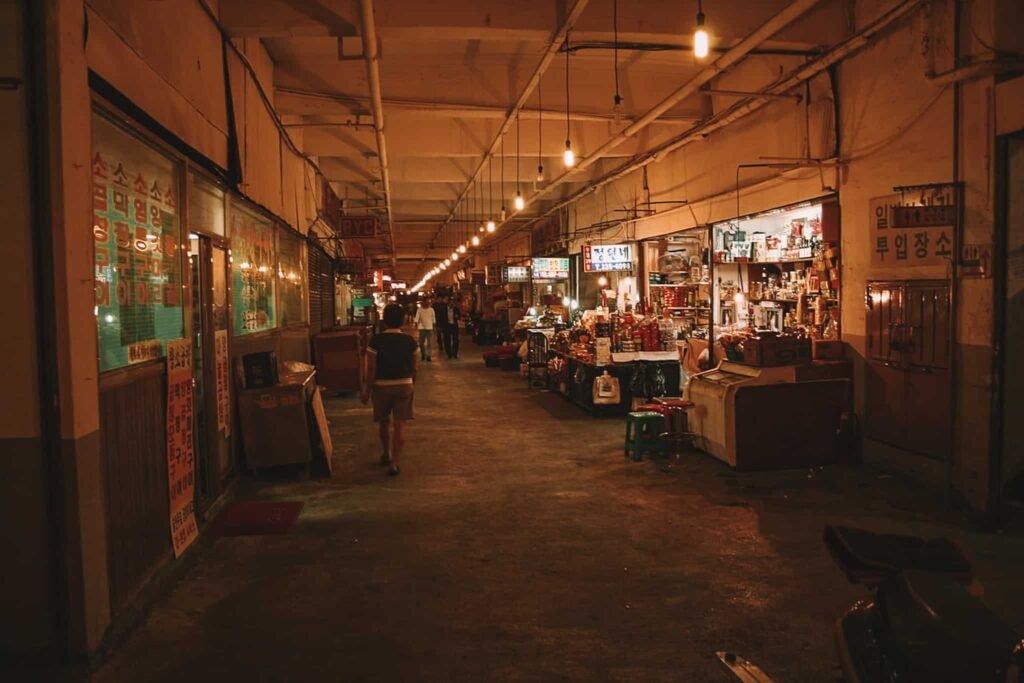I’ve spent quite some time exploring the ins and outs of Seoul, especially its bustling Korean street food scene
I’m a self-proclaimed street food connoisseur, and trust me, Seoul does not disappoint when it comes to tantalizing the taste buds with its vast array of Korean street food.
Each market I’ve visited is a unique experience in itself, brimming with culture, fun, and, of course, delicious food.
Seoul’s markets are popular hangout spots for locals who come to eat, drink, shop, and chat. You’ll feel like a proper local here, immersed in the everyday life of Koreans at their best.
So without further ado, let’s dive into the Korean street food and best markets in Seoul.
What Is the Best Korean Street Food?
There is a wide variety of popular Korean food that caters to every taste bud. Here are some of the must-try items when visiting Seoul:
Tteokbokki
Spicy rice cakes cooked in a gochujang (red chili paste) based sauce, often combined with fish cakes, vegetables, and boiled eggs.
The red sauce is not a particularly spicy sauce though the color would indicate otherwise. Turns out it is more of a sweet and spicy sauce.
The Korean rice cake skewers are made from glutinous rice flour and are sold at many street food stands.
Kimbap
Seaweed rice rolls filled with various ingredients, such as vegetables, pickled radishes, eggs, and sometimes meat or fish.
Hotteok
Sweet pancakes filled with a mixture of brown sugar, cinnamon, and chopped nuts, then pan-fried until crispy. At times you also find mung bean pancakes that contain a sweet red bean paste.
Odeng
Skewered Korean fish cakes served with a warm broth, are often available at food carts.
Pajeon
Savory pancakes are made with green onions and a variety of ingredients, such as seafood or kimchi.
Sundae
Korean blood sausage is made from a mixture of pig’s blood, glass noodles, and vegetables, steamed and served with a dipping sauce.
Twigim
Deep-fried snacks that include vegetables, fried chicken, shrimp, or squid, are served with a dipping sauce.
Mandu
Mandus are Korean dumplings and are Korean steamed buns that come with a variety of fillings.
Gamja-Hotdog
This Korean hotdog is a famous delight that you can purchase at various street food stalls. This potato hot dog comes in all types of variations. You have the sausage in the center, sometimes cheese, breading, and topped with either ketchup, mayonnaise, or mustard.
Some variations come coated in french fries or sugar. They are fried until golden brown and crispy.
Dakgangjeong
In South Korea, KFC does not mean Kentucky Fried Chicken, but Korean fried chicken. Fried chicken in Korea is an absolute must to try. The most classic Dakgangjeong comes with a sweet chili sauce.
Where to Get Korean Street Food in Seoul?
Gwangjang Market
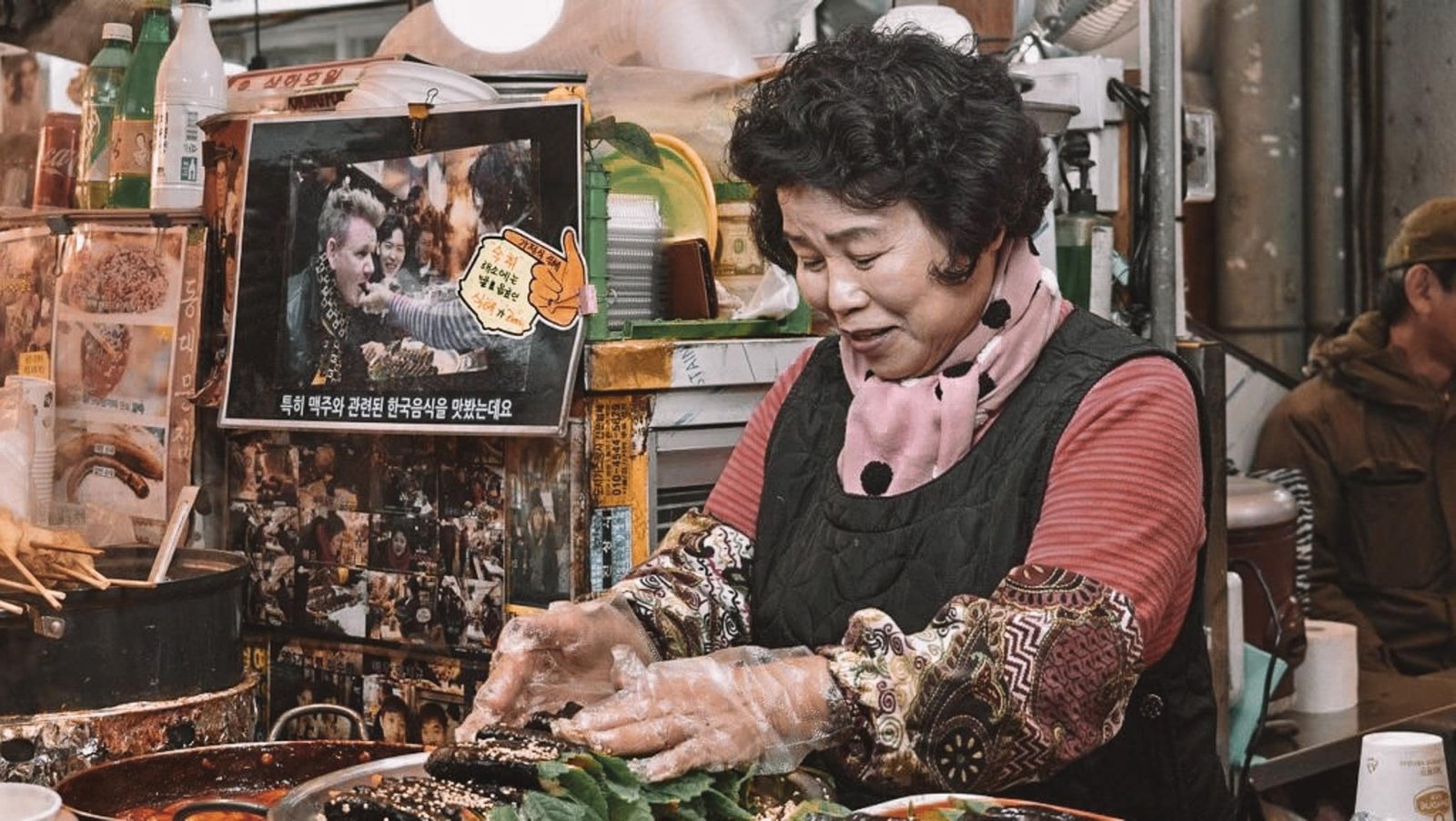
Gwangjang Market, located in the Northeastern part of the city, is Seoul’s largest traditional market.
It’s teeming with vendors selling everything from silk and linen to a variety of delicious Korean street food. The market is famous for its Korean pancakes, kimbap (Korean sushi), sausage, bibimbap, mandu, and noodles.
Gwangjang is a great market to spend some hours during lunchtime or in the afternoon. Have fun changing booths, trying different types of Korean street food, chatting, and sharing some soju, makgeolli, or beer.
Just sitting around and soaking up the energy of this buzzing place can keep you entertained for hours.
Gwangjang is located at 88 Changgyeonggung-ro, Jongno 4(sa)-ga, Jongno-gu, Seoul.
Tongin Market
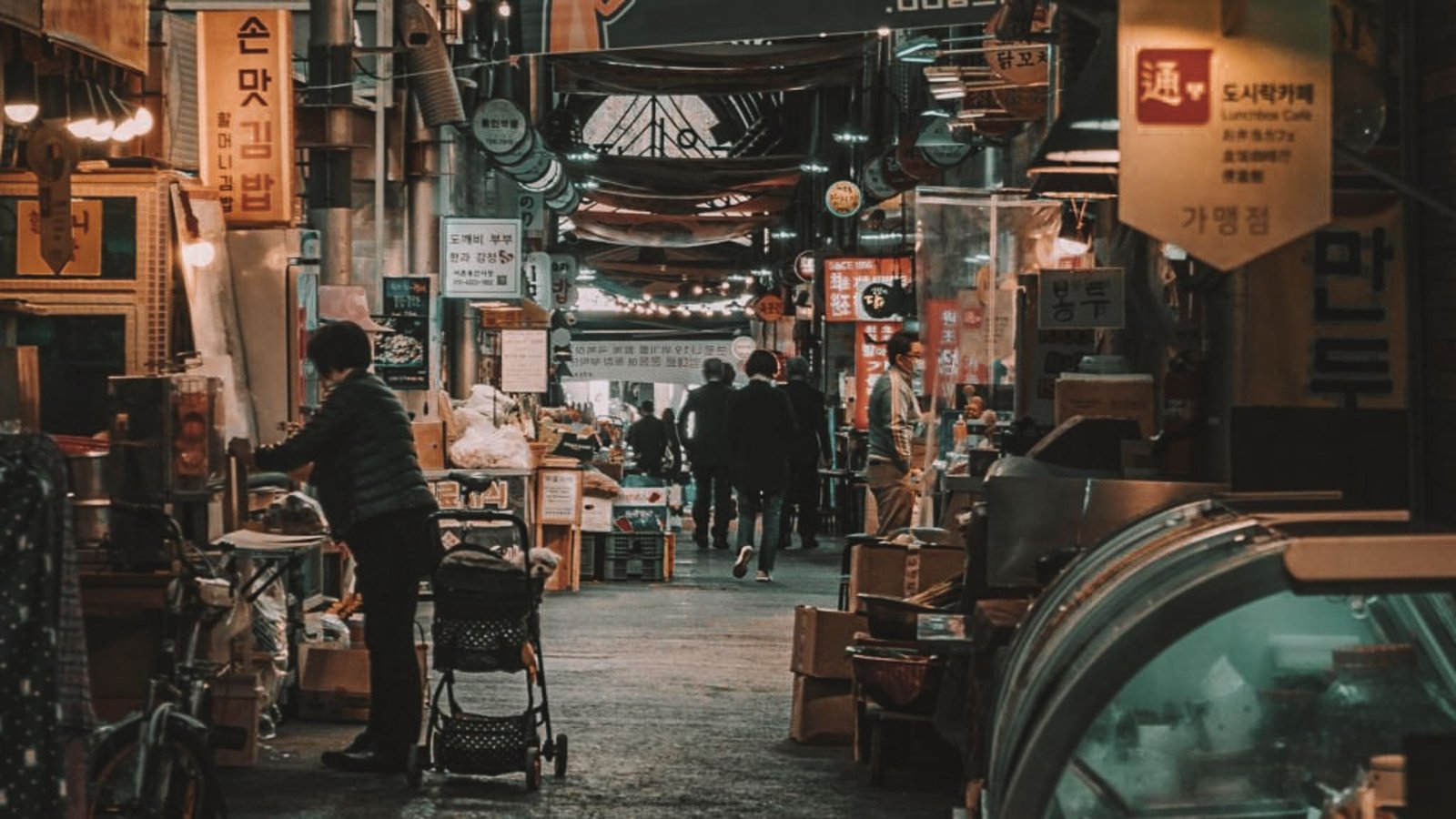
Tongin Market offers a unique and fun way to try a variety of delicious street food. Here, you buy tokens and use them to assemble your lunchbox from various Korean street food vendors.
For 5000 won you get 10 tokens and a lunchbox and can head back down. Now the fun starts as you get to assemble your lunchbox at the different vendors, for 1 or 2 tokens each place.
Take a good food tour up and down the aisleway and eye out your favorites first. The best thing about Tongin Market is that you get to taste a variety of different delicious Korean delights in just one meal – and they are all delicious!
I highly recommend tempura vegetables, mandu, tteokbokki (spicy rice cakes), and kimbap. Located near the Gyeongbokgung Palace, it’s an absolute paradise for Korean street food lovers, that you should explore in between other activities in Seoul.
Tongin Market is located at 18 Jahamun-ro 15-gil, Cheongunhyoja-dong, Jongno-gu, Seoul.
Noryangjin Fish Market

For seafood lovers, Noryangjin Fish Market is a must-visit. Located on the West side of the city, this market offers a unique experience.
Walk around and find some things that you would like to try. Noryangjin fish market is not the cheapest, but it is an entertaining way to try some fresh seafood. At least try some sashimi, steamed fish, or raw octopus.
You can select your seafood on the ground floor and then have it prepared for you in one of the traditional restaurants upstairs. It’s a fun way to enjoy super fresh seafood.
Know that this market can get a little overwhelming. I was a little surprised by the locals’ intense approach which is a big contrast to the usual Korean behaviour.
You will find the Noryangjin fish market at 674 Nodeul-ro, Noryangjin-dong, Dongjak-gu, Seoul.
Namdaemun Market
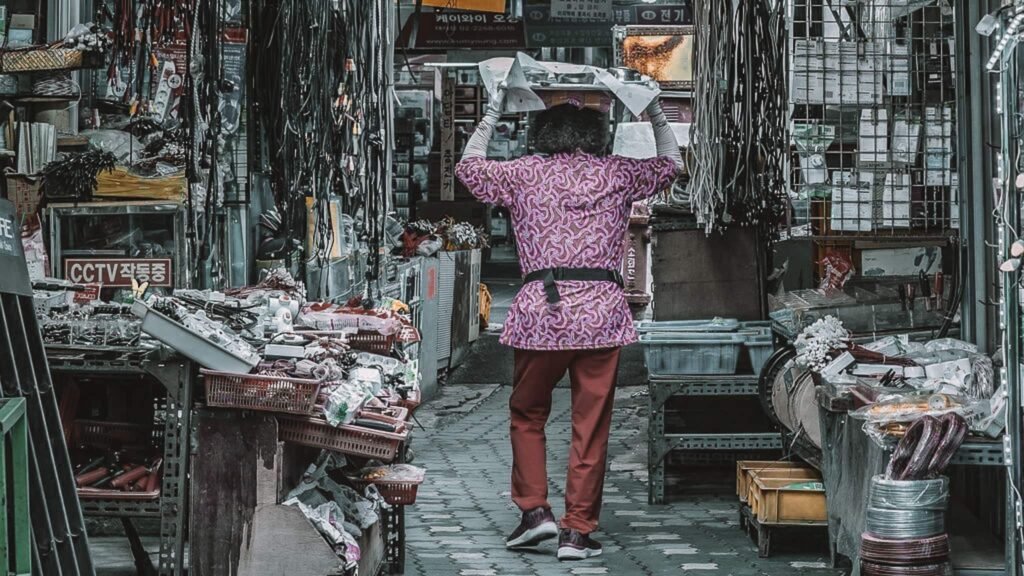
Namdaemun Market is a bustling traditional market offering a myriad of Korean street foods. You can venture down the hidden alleyways and try out the local restaurants there.
This market shows the amazing contrast and clash between the old and the new in Seoul. Namdaemun market is a very traditional place with old people working at small shops and food vendors filling the many small alleys. I advise you to go during lunchtime. Sure this is the most hectic time to go but it is also the most fun.
I once had some insanely good spicy fish stew in this tiny alley: Galchi Jorim Alley: Joongang Sikdang, 22-12 Namdaemunsijang 4-gil, Hoehyeon-dong, Jung-gu, Seoul.
Another time I crawled into a plastic tent that was a secret gateway to Kalguksu Alley – a noodle alleyway from heaven situated just near Gate 6. The alleyway is located in Kalguksu Alley, nearest Hoehyeon Station, exit 5, 60-3 Namchang-dong, Jung District, Seoul.
You find the Namdaemun market at 21 Namdaemunsijang 4-gil, Hoehyeon-dong, Jung-gu, Seoul.
Myeongdong Street Food Alley

Myeongdong food alley can be (surprise, surprise) found in the Myeongdong area. This is a fun Korean street food market, dedicated to delicious late-evening snacks. The street is packed with food stalls and people, who are walking around enjoying a few cheap, but delicious, snacks.
Try the Korean egg bread and the strawberry mochi rice cake for something uniquely delicious. In addition, you also find options like Korean tornado potato, Korean sweet pancake, spicy Korean rice cake, fried chicken, Korean corn dogs, Korean fish-shaped pastry, and Korean dumplings.
The Korean sweet pancakes usually come filled with ground mung beans.
The Myeongdong area is also a great place for late-night escapades and shopping, especially if you’re into Korean skincare.
Map of Korean Street Food Markets in Seoul
Below I made a map and included my recommendations in Seoul for you:
Korean Street Food Festivals in Seoul
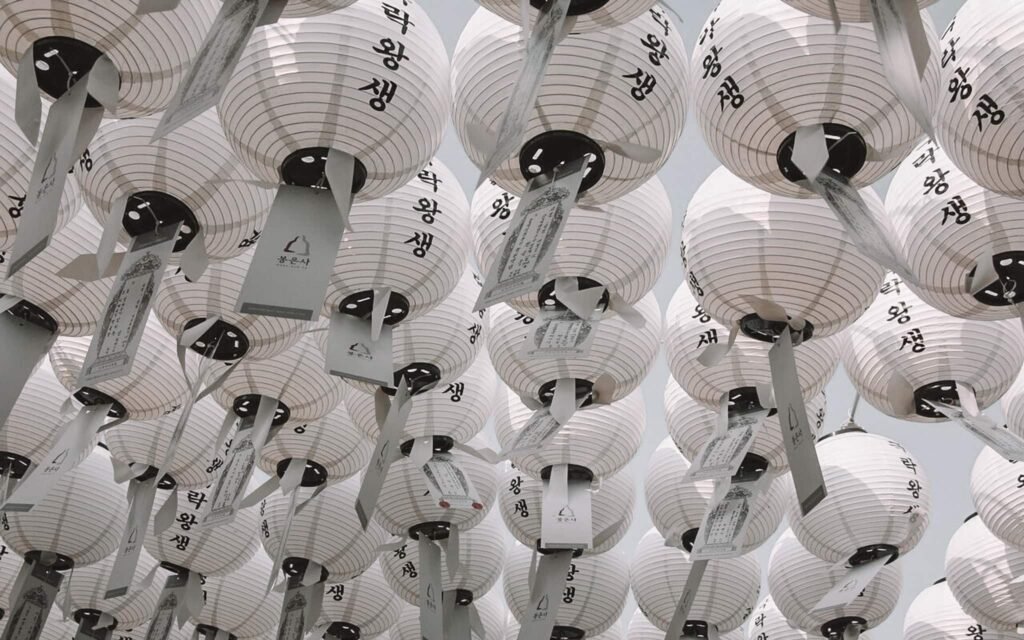
Seoul is a city that never sleeps, and its vibrant street food culture is a testament to this. Several festivals throughout the year celebrate this gastronomic love, turning the city streets into a food lover’s paradise.
Here are two of the most popular food festivals in Seoul:
Seoul Bamdokkaebi Night Market
Running from March to October, the Seoul Bamdokkaebi Night Market is a feast for the senses.
Hundreds of vendors gather in several locations around the city, offering a diverse selection of food, crafts, and other goods.
From delicious treats like tteokbokki and pajeon to unique handcrafted goods, this night market has something for everyone.
As you explore the market, you’ll also be treated to live performances and various cultural events, making it an unmissable experience for anyone visiting Seoul around this time.
Seoul Kimchi Festival
Held every November, the Seoul Kimchi Festival is a celebration of Korea’s national dish – Kimchi.
This unique event allows visitors to learn about the history of kimchi, take part in a communal kimchi-making event, and, of course, taste different varieties of this iconic fermented dish. The kimchi fried rice is an all-time classic.
The festival is not just about food but also about community and tradition, reflecting the deep cultural significance of kimchi in Korean society.
Whether you’re a kimchi connoisseur or a curious newbie, this festival is sure to leave you with a deeper appreciation of Korean cuisine and culture.
Street Food Beyond Seoul
While Seoul is a veritable paradise for street food enthusiasts, other cities in Korea offer a unique gastronomic journey through their vibrant food scenes.
In Busan, Korea’s second-largest city, one must not miss the ssiat hotteok, a sweet pancake stuffed with seeds, honey, and cinnamon.
Jeonju, the food capital of South Korea, is famous for its bibimbap and food markets. And let’s not forget about Gwangjang Market in Gyeongju, known for its traditional Korean snacks such as chalboribbang, a sweet red bean pancake.
Venturing beyond Seoul not only allows you to taste different regional specialties but also gives you a broader sense of Korea’s diverse culinary landscape.
The Korean Street Food Culture

Korean street vendors and food have a long and rich history that can be traced back to the Joseon Dynasty (1392-1910). During this time, street vendors sold simple snacks and dishes to the public. Many of these traditional foods have evolved but remain popular today.
In the late 19th and early 20th centuries, with the opening of Korea to foreign trade, new ingredients, and culinary influences started to make their way into the Korean food scene.
Items like kimbap and hotteok were influenced by Japanese and Chinese cuisine, respectively, and have become integral parts of Korea’s food culture.
After the Korean War (1950-1953), street food played a significant role in the daily lives of Koreans, as it provided an affordable source of sustenance during difficult times.
As the country’s economy grew, the street food culture continued to thrive, and the variety of dishes expanded.
Today, Korean street food is an essential aspect of Korea’s culinary identity. Food markets are bustling hubs where locals and tourists alike can indulge in an array of delicious dishes.
These markets also serve as social spaces, where people gather to eat, drink, and chat, highlighting the role of food in bringing people together.
So, when you visit, don’t miss the opportunity to delve into the vibrant food scene and experience a taste of Korea’s culture.
Final Thoughts on Korean Street Food
Diving into the world of Korean street food was the highlight of my time living and studying in Korea. Seoul, along with other major cities, offers an incredible variety of street foods that are as much a feast for the senses as they are a reflection of the country’s rich cultural tapestry.
What sets Korean street food apart isn’t just the flavors, but the stories behind each dish and the vendors’ passion for sharing their culinary heritage. From the savory delight of tteokbokki to the sweet allure of hotteok, the street food scene invites you to connect with Korea’s history and its people’s warmth.
I hope you liked this article on Korean street food and the best street food markets in Seoul. Since you are heading to South Korea, be sure to also read:
- Where to Stay in Seoul | Discover the Best Accommodation Options
- Bukhansan Mountain Near Seoul | Incredible Hiking in South Korea
As usual, feel free to leave a comment below.
// Josephine
Frequently Asked Questions
Korean street food consists of various snacks and dishes sold by vendors at markets and street stalls throughout Korea. It’s a vital part of Korean food culture, offering an array of tastes from savory to sweet. Some other popular Korean street food items include tteokbokki (spicy rice cakes), kimbap (seaweed rice roll), and hotteok (sweet pancakes).
Korean street food is typically very affordable. Prices can range from 1,000 to 5,000 KRW ($0.60 to $3.50) per item, making it a delicious and budget-friendly way to explore Korean cuisine.
Tteokbokki is probably the most popular Korean street food. It’s a dish made of chewy rice cakes cooked in a spicy and slightly sweet red chili sauce. Other favorites include sundae (blood sausage), pajeon (green onion pancake), and odeng (fish cake).
While some Korean street food can be spicy, like tteokbokki or spicy Korean chicken skewers, many are not. There’s a wide variety of flavors available, from the sweet taste of roasted sweet potatoes or Korean sponge candy to the savory delight of kimbap.
Absolutely! The street food scene in Seoul comes alive at night, especially in areas like Myeongdong and Hongdae. This is a great time to experience the city’s vibrant food culture.
